The original concept of the thin client device, which Hewlett-Packard helped pioneer, was to strip the PC down to just the minimum hardware needed to serve as a decent enough remote access terminal, while moving the compute power to the data center. But with new private cloud architectures enabling businesses to shift computing power between processors as needed, suddenly there’s a trend toward fattening the thin client.
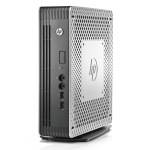
Yesterday, HP announced the replacement of two components in its thin client product line with some hardware components that would actually turn a few heads if they were released as ordinary desktop PCs. The first adds one of AMD’s newest Fusion processors with built-in GPU, and the second marks the latest step in the comeback of one of a much-loved brand among system builders.
HP’s new t610 series thin client, which replaces the t5740, adds AMD’s dual-core 1.65 GHz Fusion G-series processor. AMD calls it an “APU” rather than a CPU/GPU. It was introduced at about this time last year and made its way into the high end of HP’s value line of Pavilion laptops. It’s the presence of this not-so-ordinary APU from the mobile world that is enabling HP to exploit this thin client form factor in ways it couldn’t before.
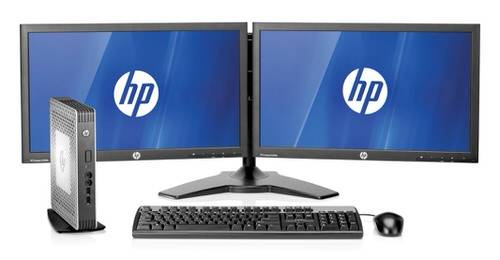
“This will be the only thin client in the world with a thermal management capability,” says Allen Tiffany, HP’s thin client marketing manager, in an interview with RWW. “The box itself is rated to 40 degrees Celsius [104° F], so it can already withstand some very harsh operating environments. However, customers being customers, every now and then they do something out of spec.”
Tiffany and I shared some horror stories to that effect, me with the tale of a bank branch that duct-taped its thin client boxes under their desks in the gap between the front drawer and the backboard (which then overheated, charring the wood), Tiffany with the story of customers who drop their thin clients in locked filing cabinets and leave the power cords hanging out from the front.
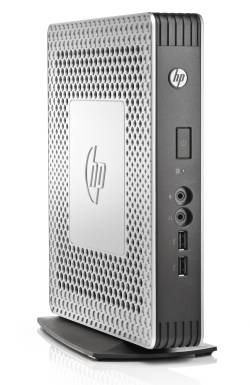
Now when the ambient temperature exceeds 40° C, he tells me, the t610 will begin a process of stepping down the CPU’s operating level until it’s back within a safe operating range.
“Doing this allows us to best provide for ensuring the components have a very long life cycle,” says Tiffany, “and we don’t do any damage to the device by putting it into an excessively hot environment.” The fact that the t610’s dual Wi-Fi antenna are both self-contained also encourages customers to expose it to the open air, rather than hide it in the desk drawer with the Halloween candy.
The slightly wider space in the so-called “flex chassis” of the t610 Plus (left) gives space for one PCI-Express expansion slot (see what I mean about the desktop PC transition?). It also enables a quad-head display connector, which will make the device right at home in a financial management setting.
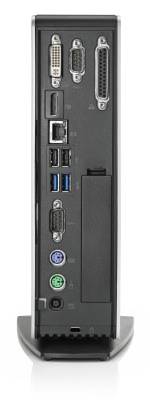
One more desktop-like feature that got my attention was the inclusion of a Trusted Platform Module, enabling the t610 to serve as a trusted component in a government setting where full session encryption is vital. Although IBM had been working on a TPM for Linux-based thin clients at least as early as 2005, this is probably the first commercial implementation on a Windows-based thin client.
Tiffany adds the t610’s BIOS will also meet NIST’s guidelines for BIOS protection (April 2011 edition as PDF here). So clearly HP is making a play for the government and public services markets, where the rapid migration to private cloud architectures has already shifted compute power to the server.
HP’s other thin client introduction this week, more in the value space, is the t510 (right). It replaces the existing t5500, and marks the next step forward in the comeback of former system builder favorite Via Technologies. Via’s niche today is the low-power space, so the t510’s dual-core Eden X2 U4200 processor may not always turn heads. But it enables Via’s ChromotionHD 2.0 graphics technology, which is optimized for playing back 1080p full-motion video – and that’s something to see.
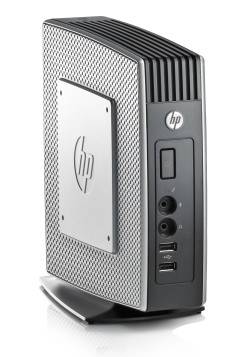
Tiffany confirmed that both t510 and t610 are both certified Citrix Ready, which means they’re verified to work well with Citrix’ Xen-brand application virtualization. The next step up in Citrix’ certification system is HDX Ready, which Citrix announced last October. That tier is for devices that can utilize Citrix’ HDX streaming, which lets thin clients serve as both superior graphics workstations and videoconferencing terminals. The HP manager said he expects both models to obtain HDX Ready certification soon.
He also reminded us that all HP thin clients will continue to come pre-installed with HP’s Embedded Device Manager software, which premiered last December. This way, any thin client can serve as an administration station for the entire branch office.










